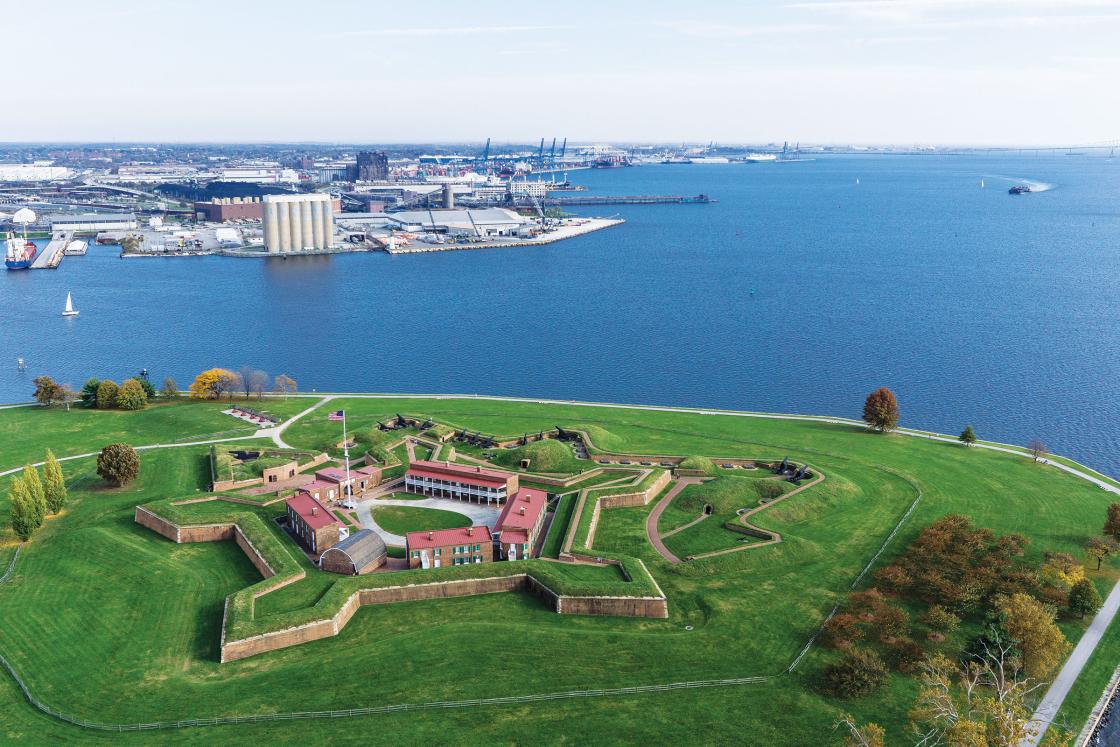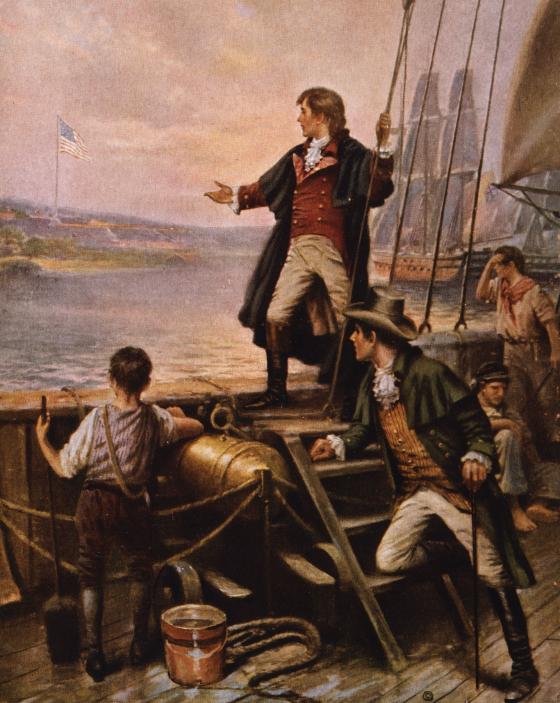O Say Can You See: The Bombardment of Fort McHenry

At 6:30 a.m., on September 13, 1814, the first of an estimated 1,800 cast-iron bomb shells were hurled at the masonry walls of Fort McHenry. The British attack on Baltimore had began in earnest.
A national subscription magazine published locally, Niles’ Weekly Register, recorded that “the houses in the city were shaken to their foundations for never, perhaps from the time of invention of cannon to the present day, were the same number of pieces fired with so rapid a succession.” The vivid display of early 19th-century shock and awe could be heard 100 miles away inPhiladelphia.
Among the 20 low-draft vessels, primarily frigates and schooners, of the British squadron, five were particularly ominous. They were infamous bomb ships, with names that hawked of their ominous purpose — HMS Devastation, Meteor, Aetna, Volcano and Terror — capable of hurtling a 200-pound shell one mile high before it plunged in its downward arc over the Patapsco River to its target. The newest bomb ships of the Vesuvius class were three-masted vessels carrying a massive central weight of 325 tons, with a length of 102 feet, ideal for heavy weather and shore bombardment. It was England’s most powerful naval armament, floating siege ships capable of inflicting severe damage and further supported by the rocket ship HMS Erebus with her 32-pounder Congreve rockets, and several light draft frigates and brigs. Their goal was to push through the narrow passage, past Fort McHenry and through to the city itself, in concert with the planned infantry assault from the northwest.

The British naval arc stretched across the Patapsco two miles below Fort McHenry, keeping distance from the fort’s powerful 36-pounder French naval shore batteries. For three hours, the bombardment proceeded through lashing rain, thunder and lightning. But by 9:30 a.m., Admiral Cochrane knew his fleet would be mired for the foreseeable future — those shore batteries, coupled with a chain-mast boom, sunken vessels, U.S. gun boats and the Lazaretto Battery, presented a formidable harbor defensive line — and any infantry assault would lack naval support. Still, the decision for ground troops to either advance or retreat fell to Colonel Arthur Brooke, who had assumed command following the death of the much-esteemed General Robert Ross at North Point the previous day. Cochrane dispatched the assessment to his colleagues ashore:
“It is impossible for the Ships to render you any assistance — the Town [of Baltimore] is so far retired within the Forts. It is for Colonel Brooke to consider under such circumstances whether he has Force sufficient to defeat so large a number as it [is] said the Enemy has collected; say 20,000 strong. Without this can be done it will only be throwing the Men's lives away:”
This response would not reach Colonel Brooke until noon, when he had advanced within two miles east of the American lines while he and Cockburn surveyed the American lines.

A Military Conference
By noon, Brooke had come within two miles east of the American lines, surveying any opportunities for an infantry breakthrough, but found none. He withdrew without firing a shot, but outlined a proposal for two flanking night assaults on the vulnerable American right flank, while a third column would make a feint on the American left after midnight on September 14. He sent sent a message, via Admiral Cockburn, to Cochrane regarding how the two could act in concert together, one by land, one by sea. Tensions were high in the British command infrastructure. Directives from London were clear that once troops went ashore, combat decisions belonged with the army rather than the navy, but such guidance had not anticipated that those soldiers might be under the command of a mere colonel. Chafing at the need to coordinate with an officer so junior to his rank, all Cochrane could do was reiterate his assessment and make his disapproval known, hoping that it would sway Brooke.
The situation was complicated by the long lag time in communications. Cochrane sent his note around nightfall, without any expectation he would receive a response before the plan he had in hand would require him to act. The commander in chief had no way of knowing that in response to his latest note, Brooke had, in fact, ordered the infantry retreat from Baltimore to begin by dawn. Accordingly, he launched a late evening diversionary barge attack on the western shore, the backdoor of the American land defenses.

A storm still raged around Baltimore as the most tremendous cannonade of the battle took place. “The hissing rockets and the fiery shells glittered in the air, threatening destruction as they fell,” later recalled a young British sailor, in a description that sounds straight out of a poem, “Whilst to add solemnity to this scene of devastation, the rain fell in torrents — the thunder broke in mighty peals after each successive flash of lightening, that for a moment illuminated the surrounding darkness.” But with no coordinated infantry assaults, Cochrane began to draw down his thrust.
By early morning of September 14, it was over. The British army broke camp and began its retreat; the last of the failed naval barges returned to the fleet. At 4:30 a.m., the American batteries fell silent, followed at 7:30 a.m. by the last British bomb to arc over the Patapsco River toward Fort McHenry. Two days later, having reembarked the land forces, the fleet sailed down the Chesapeake, soon to receive new Admiralty orders to attack the port of New Orleans, an engagement that took place before word could arrive that peace had been secured through a conference in Ghent, Belgium.
At 9:00 a.m., Fort McHenry’s massive garrison flag — measuring an imposing 30'x 42' — was raised over the ramparts, as four young fifers and drummers played the national tune “Yankee Doodle.” Aboard the frigate HMS Hebrus, a young midshipman remembered: “And as the last vessel spread her canvas to the wind, the Americans hoisted a most superb and splendid ensign on their battery, and fired at the same time a gun of defiance.” The great ensign, receiving the sun's early light, could be seen plainly for miles. Its message was clear: The British threat had passed, and Baltimore was saved.

Often lost in the near-mythic symbolism attached to this moment in the American consciousness is the fact that Fort McHenry’s commander, Major George Armistead, did not order the flag hoisted in a special act of triumph or defiance. It was simply raised according to the 1808 U.S. Regulations of the War Department: Each morning began with a round from a six-pounder and musical accompaniment as the flag was lifted aloft.
From the harbor below Fort McHenry, these events were witnessed — without understanding that they were standard practice — by those aboard a Baltimore packet vessel, President, now serving as the U.S. flag-of-truce vessel. The ship carried Colonel John S. Skinner, U.S. State Department prisoner exchange agent, and 35-year-old Georgetown attorney Francis Scott Key. Their vessel had been held in security by Cochrane’s flagship HMS Surprise out of range of the American guns. Skinner and Key had been dispatched to obtain the release of the elderly Dr. William Beanes, who had been taken prisoner during the Washington campaign for confronting three British soldiers.

In the twilight hours of Friday, September 16, the President was released and docked alongside Hughes Wharf at Fell’s Point. Key took quarters for the night at the Indian Queen Hotel, bringing with him the rough draft of a poem he had composed during his ordeal. That night, Key finalized the four stanzas of the “Defense of Fort McHenry.”
Three days later, the poem was printed on a broadside alongside the melody to a popular English tavern 1780 tune, “To Anacreon in Heaven.” A thousand copies were distributed to the garrison of Fort McHenry: A young militia soldier wrote his family “We have a Song composed by Mr. Key of G[eorge] Town which was presented to every individual in the fort.” By mid-autumn, further pnntmgs contained musical notations and a new title: “The Star-Spangled Banner.”
In 1834, Key spoke at a public gathering in Frederick, Maryland — where he was born and now rests in peace — offering his only personal remarks about those three days in September 1814.
“Through the clouds of the war the stars of that banner still shone in my view, and I saw the discomforted host of its assailants driven back in ignominy to their ships. Then, in that hour of deliverance and joyful triumph, my heart spoke, and Does not such a country and such defenders of their country deserve a song?' was its question.”
More than two hundred years since the “perilous fight" over Baltimore, the legacies of the “Old Defenders of Baltimore of 1814” are remembered annually on “Defenders' Day.” And the American flag — now with 50 stars rather than 15 — flies, by presidential proclamation, over Fort McHenry day and night.

Related Battles
28
1



